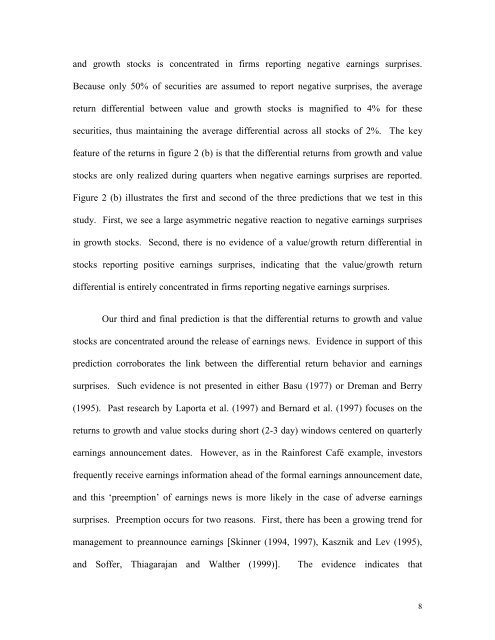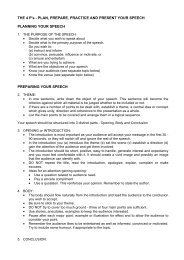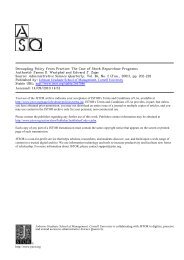Earnings Surprises, Growth Expectations, and Stock Returns:
Earnings Surprises, Growth Expectations, and Stock Returns:
Earnings Surprises, Growth Expectations, and Stock Returns:
Create successful ePaper yourself
Turn your PDF publications into a flip-book with our unique Google optimized e-Paper software.
<strong>and</strong> growth stocks is concentrated in firms reporting negative earnings surprises.<br />
Because only 50% of securities are assumed to report negative surprises, the average<br />
return differential between value <strong>and</strong> growth stocks is magnified to 4% for these<br />
securities, thus maintaining the average differential across all stocks of 2%. The key<br />
feature of the returns in figure 2 (b) is that the differential returns from growth <strong>and</strong> value<br />
stocks are only realized during quarters when negative earnings surprises are reported.<br />
Figure 2 (b) illustrates the first <strong>and</strong> second of the three predictions that we test in this<br />
study. First, we see a large asymmetric negative reaction to negative earnings surprises<br />
in growth stocks. Second, there is no evidence of a value/growth return differential in<br />
stocks reporting positive earnings surprises, indicating that the value/growth return<br />
differential is entirely concentrated in firms reporting negative earnings surprises.<br />
Our third <strong>and</strong> final prediction is that the differential returns to growth <strong>and</strong> value<br />
stocks are concentrated around the release of earnings news. Evidence in support of this<br />
prediction corroborates the link between the differential return behavior <strong>and</strong> earnings<br />
surprises. Such evidence is not presented in either Basu (1977) or Dreman <strong>and</strong> Berry<br />
(1995). Past research by Laporta et al. (1997) <strong>and</strong> Bernard et al. (1997) focuses on the<br />
returns to growth <strong>and</strong> value stocks during short (2-3 day) windows centered on quarterly<br />
earnings announcement dates. However, as in the Rainforest Café example, investors<br />
frequently receive earnings information ahead of the formal earnings announcement date,<br />
<strong>and</strong> this ‘preemption’ of earnings news is more likely in the case of adverse earnings<br />
surprises. Preemption occurs for two reasons. First, there has been a growing trend for<br />
management to preannounce earnings [Skinner (1994, 1997), Kasznik <strong>and</strong> Lev (1995),<br />
<strong>and</strong> Soffer, Thiagarajan <strong>and</strong> Walther (1999)]. The evidence indicates that<br />
8







